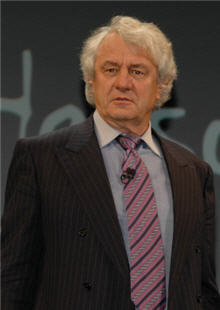Hasso Plattner outlines SAP's software vision


I asked Plattner whether the departure of Shai Agassi, who headed products and technology for SAP under Plattner's tutelage, would affect day-to-day involvement with the company. He is Chairman of the SAP Supervisory Board and teaches at Hasso Plattner Institute of Design, which he funded with a $35 million donation, at Stanford University. "Instead of having all my discussions with Shai, there are four different groups, which is back to the organization of 2003," Plattner said. "When you are not in an executive job, you can pick and choose a bit. I am fascinated by in-memory databases, communities, and user-centered design."
Plattner's description of the next-generation, on demand business suite was similar in many ways to what salesforce.com has developed over the last eight years with its applications, platform and ecosystem, and what PeopleSoft founder Dave Duffield is creating at Workday.
SAP is late to the on demand game, but has been working over the last three years on A1S to catch up. Plattner said that SAP's A1S on demand offering will be broader than salesforce.com or Workday, covering the entire business suite and different industries. In that context it sounds closer to NetSuite in covering the entire spectrum of core business applications, but SAP has the advantage of deep expertise across industry verticals, a set of more than 2000 enterprise services and a large war chest for marketing the products and services. Plattner views SAP's role as spawning an ecosystem of innovation and serving as the primary trusted partner to customers.
Like NetSuite, SAP will face the issue of selling into mid-size and smaller companies with the notion of replacing their financial systems and other business functions, which isn't as easy as telemarketing an on demand CRM application. However, the on demand message is getting across to CIOs and CFOs in terms of return on investment with every passing month.
So far, SAP hasn't shown A1S in public. Given how much is riding on this SAP initiative, it will have to live up the standards that Plattner set during his keynote. During that hour and fifteen minute keynote, Plattner described the aspects of what he called the "new idea." Among the characteristics are:
- Leveraging SOA as a design principle
- Cloud computing, with on demand as one of the deployment options
- Modular deployment
- Community--wikis, blogs, chat, videos, social networks
- Collaboration
- Horizontal standards
- No code exposed
- Model-based configuration
- Events and triggers
- Real-time analytics
- In-memory databases (T-Rex
- User-centered design
- Separating the user interface from the application
- Harmonized user interface across delivery platforms (browsers, clients, devices)
- Completely portal based
- Search as a starting point for activities
Hasso Plattner outlined the core components of his New Idea for business suites, with data and process models, the user interface abstracted from applications, an enterprise services repository (ESR), real-time analytics, compositions tools for mashing up applications and services and community.
Plattner emphasized leveraging SAP's community, 2,000 partners and 10 million users, as a key to success. It's at the center of his diagram above, and also a recognition of the open source way of doing things, allowing the community to contribute, participate in the design and evolution of products and service on a continuous basis.
He also outlined the advantages of the on demand model--faster development, faster testing, lower cost of ownership and community--and various ways to set up on demand services, such as multitenant and single tenancy.
At the root of the Big Idea is a services approach, model-based development, community-driven ecosystems and business suites that are no longer monolithic, but composed of thousands of internal and external services that rearranged, replaced and easily modified. It's a new world, and we'll have to wait and see whether SAP's A1S is a new leader or just a well endowed follower.